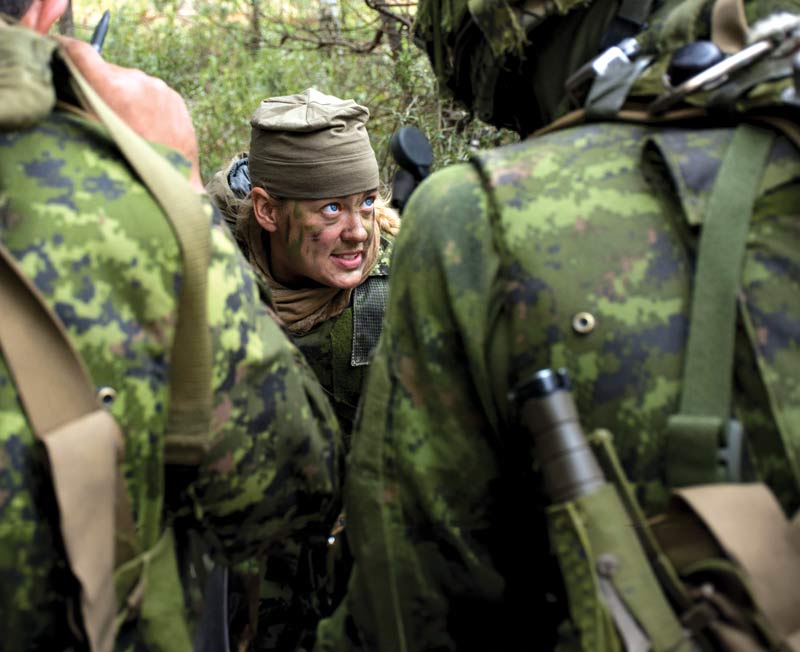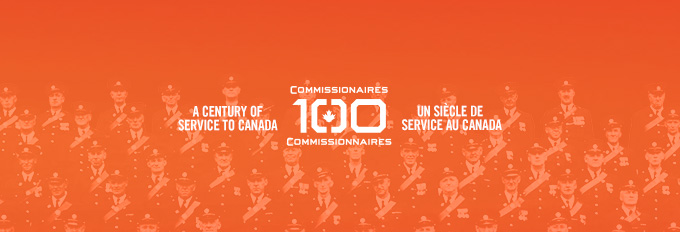
Major Chelsea Anne Braybook, 1st Battalion, Princess Patricia’s Canadian Light Infantry, briefs colleagues during a NATO exercise in Latvia in 2017. [Master Corporal Gerald Cormier/Combat Camera/RP12-2017-0083-012]
The present state of the Canadian Armed Forces is, in a word, pathetic.
There’s a shortage of some 16,000 personnel in the regular and reserve forces combined. The Royal Canadian Navy can scarcely put its ships to sea for lack of sailors, and the Royal Canadian Air Force is running out of pilots for its aging, 1980s-era fighter jets and is outsourcing advanced flight training to other countries. The army’s infantry battalions, meanwhile, are at half strength, specialists are in short supply, and reserve units are under strength and underfunded. Plus, existing equipment is run down and replacements are behind schedules and over budgets.
The procurement system, when it works at all, moves at a glacial pace. The government has been cutting budgets despite its pledge to NATO to spend two per cent of the country’s gross domestic product (GDP) on its military. It’s a mess, but the feds attempted to begin fixing matters with the new defence statement in April.
Here are a few of the major problems Canada’s military is facing and what, if anything, the defence statement had to say about them.
First, the Trudeau government might have sent a quick, positive message to the troops by reversing its decision to cut almost $1 billion from the annual allocations to the Defence Department in each of the next two years. The cuts will continue, but there’s said to be $8 million in new money coming during the next five years.
Second, the recruiting issue needs to be fixed. A report to Defence Minister Art Eggleton in 2000, “In Service of the Nation: Canada’s Citizen Soldiers for the 21st Century,” noted myriad complaints, including problems with the recruiting process. Twenty-five years later, little has changed. In late 2022, the Defence Department did expand the pool of potential force members to permanent residents and subsequently more than 21,000 applied.
But security screenings, required of all applicants, can take 18 to 24 months, and just some 100 of the applications have since been approved; the remainder still to be concluded when, after months of waiting, the vast majority of those seeking to enlist moved on to other employment. How can this be fixed? Speed up security clearances, aggressively recruit specialists and offer better conditions for serving personnel. The defence statement said the government would take such steps. It had better do so, or what Defence Minister Bill Blair called the CAF’s “death spiral” will only continue.
Third: defence procurement is seemingly in disarray.
The Liberal government’s platform for the 2019 election stated that “to ensure that Canada’s biggest and most complex defence procurement projects are delivered on time and with greater transparency to Parliament, we will move forward with the creation of Defence Procurement Canada.” This was a good idea, one long sought by the Defence Department. But nothing happened, leaving the military’s procurement in the hands of two or more of the three government departments—Defence, Public Services and Procurement Canada, and Innovation, Science and Economic Development Canada—most involved.
Cabinet ministers are also always involved, seeking kudos for getting jobs for their constituents. It’s a patronage and public service swamp that has stopped the CAF from getting a new pistol for years and new trucks for a decade, and will likely keep new aircraft and ships on the drawing boards for ages. Canada can’t even produce artillery shells fast enough to replace those given to Ukraine.
Canada’s credibility with its allies is on the line.
This needs to be sorted out now with one minister and one department ultimately responsible and accountable for military procurement. Regrettably, the defence review only promised a study of the procurement system. Leaving a broken system in place at a critical time simply isn’t good enough.
Finally, the government needs to state that it will—honestly—meet its pledge to NATO to dedicate two per cent of the country’s gross domestic product (GDP) to defence. This would mean adding some $20 billion to the Defence Department’s present budget, admittedly a difficult task when Ottawa is already running an estimated $40-billion deficit this year. But global security seems tenuous these days with tensions rising between the West and Russia, China, North Korea and Iran. And Canada’s credibility with its allies is on the line. The increase needn’t happen all at once, but it must be done within, at most, two or three years to support a full-strength military with modern equipment.
And it can’t include (as NATO presently allows in its calculations of members’ spending), military pensions, the costs of Canada’s cryptologic agency, veterans’ benefits, the RCMP’s bills for its personnel participating in peacekeeping, and the expenses borne by other federal departments when they support the Defence Department. The CBC concluded in late 2019 that such expenditures added nearly $5 billion a year to the financial numbers Canada sends to NATO. In other words, while Ottawa reports it currently spends 1.38 per cent of the country’s GDP on defence, it’s actually about 1.1per cent when those costs are removed.
The defence review is replete with promises of major spending on new equipment, more personnel, daycare for children of those serving, better health care, improved infrastructure and more. Unfortunately, all of this is to be done within a 20-year time frame. No government can make such promises, especially one that must call an election by fall 2025. These are nothing but paper pledges by a government that hasn’t been good at keeping its word.
So, what’s in the defence review that’s concrete? Some small amounts of money over the next five years; more personnel to be found through a sound recruiting system; a study of the procurement process; and a wobbly “commitment to reach defence expenditures of 2% of gross domestic product…as agreed by NATO members.”
But global security is increasingly fragile these days, and therefore, so is Canada’s safety. “Nothing was ready for the war which everyone expected,” wrote Leo Tolstoy in War and Peace as Napoleon’s invasion of Russia was coming in 1812. That, regrettably, seems eerily similar to Canada’s current situation: there’s little preparation for conflict that may well be coming. This must change.
Advertisement


















